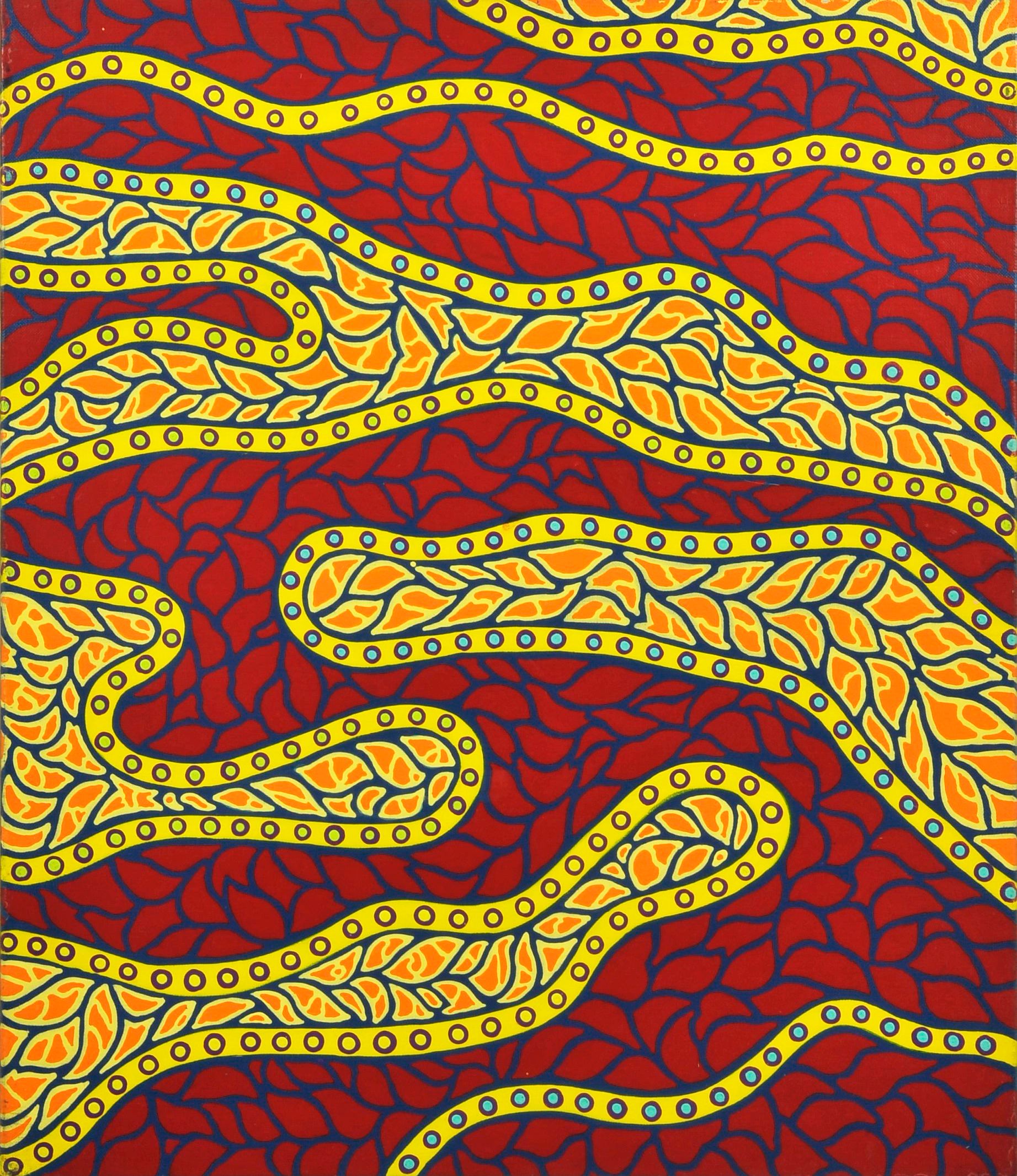Yayoi Kusama
Dinosaur’s Village
, 1987Undulating, organic and colourful forms, typically, unfurl across the surface of Yayoi Kusama’s Dinosaur’s Village, executed in 1987, a good example of Kusama’s command over spatial abstraction and hypnotic language of mark-making. Characterized by its rhythmic structure, which emphasizes the artist’s distinct aesthetic vocabulary, the composition merges technical mastery with profound psychological depth.
The painting is elegantly articulated through networks of pictorial fields, where each layer of meticulously applied paint contributes to a topographical quality that grants the surface vibrancy. The evocative palette imbues the canvas with a distinct luminosity, drawing viewers into a composition that seems to pulsate and hum kinetic energy. Harnessing a rhythmic and trance-like power, Dinosaur’s Village thus generates a heightened visual and psychological intensity that immerses the viewer into a realm of both meditative tranquility and chaotic dynamism.
Repetition, infinity, self-obliteration, and obsessive patterning are themes and motifs that pervade Kusama’s oeuvre and are evident in the dots and patterns of Dinosaur’s Village. Blurring the boundaries between illusion and reality, nothingness and infinity, selfhood and self-obliteration, Kusama’s hypnotic mark-making foregrounds an artist’s journey towards spiritual stability and respite from psychosomatic anxiety.
Considering how personally resonant her practice is, it is difficult to separate the tumult of Kusama’s life from the works that she produces. As a young artist trained in both Western and Japanese traditions, she emigrated to the United States, arriving in New York City in 1958 where she would remain for fifteen years. While many publications discuss the psychiatric histories of Kusama’s childhood, the artist’s time in New York was also riddled with hardship. Although she was incredibly productive and driven upon her arrival in New York and made important connections with artists such as Georgia O’Keeffe (1887 – 1986), Donald Judd (1928 – 1994), On Kawara (1933 – 2014), and Joseph Cornell (1903 – 1972), the racism and sexism prevalent in the white-male-dominated art world presented countless obstacles to the ambitious young artist. Her artworks from this period are widely considered transformative and pivotal to her career but were also a source of frustration and disappointment to Kusama, leading to her eventual return to Japan in 1973.
Upon her return to Japan, Kusama became so depressed that she was unable to work. After a suicide attempt, she, in 1977, found a doctor who was using art therapy to treat mental illness in a hospital setting. She checked herself in and eventually took up permanent residence in the hospital. She has been living at the hospital ever since, by choice. Her studio is a short distance from the hospital in Tokyo and Kusama is often quoted as saying: ‘If it were not for art, I would have killed myself a long time ago.’ From this base, she has continued to produce artworks in a variety of media, as well as launching a literary career by publishing several novels, a poetry collection, and an autobiography.
After relocating to Japan Kusama’s painting style shifted to high-colored acrylics on canvas, often on an amped-up scale. Kusama developed a breadth of visual semantics that prioritized repetition, accumulation, and infinity, and ultimately defies categorization or affiliation to any specific artistic movement. According to art historian Mignon Nixon (Professor of Modern and Contemporary Art History at University College, London), Kusama set out to “replace the expressive gesture with an exhaustive one, pushing painting to its limits of spatial extent and ‘monotony;’ and to obliterate the self, reconceiving contemporary painting from a subjective statement of individual consciousness to ‘nothingness’ on an epic scale” (‘Infinity Politics’ in Yayoi Kusama, exhibition catalogue, Tate Modern, London, 2012).
With a process that is at once meditative and obsessive, Kusama demonstrates her singular devotion to artistic creativity and her interrogation of life, death, trauma, and infinity. Dinosaur’s Village presents a testament to the artist’s relationship with her own practice, how her art has been a vital form of personal therapy but also an expression of philosophical and aesthetic questions that have rewritten the grammar of contemporary art. Utterly spellbinding to artist and viewer alike, the present work’s elegant palette and intricate construction deliver an immersive experience for us to glimpse into Kusama’s fantastical spiritual dimension.
Signed, titled and dated on verso.
Provenance
Shinwa Art Auction Co., Ltd., Tokyo, Modern Art, 23 November 2014, lot 149.
Firestorm Foundation.
Copyright Firestorm Foundation
